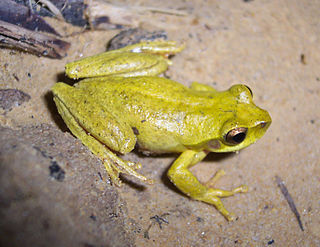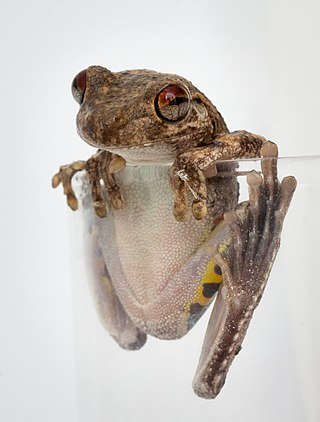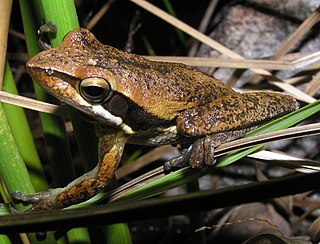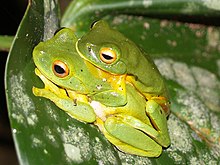
Agalychnis callidryas, commonly known as the red-eyed tree frog, is a species of frog in the subfamily Phyllomedusinae. It is native to forests from Central America to north-western South America. This species is known for its bright coloration, namely its vibrant green body with blue and yellow stripes on the side. It has a white underside, brightly red and orange colored feet, and is named after its distinctive bright red eyes.

The Australian green tree frog, also known as simply green tree frog in Australia, White's tree frog, or dumpy tree frog, is a species of tree frog native to Australia and New Guinea, with introduced populations in the United States and New Zealand, though the latter is believed to have died out. It is morphologically similar to some other members of its genus, particularly the magnificent tree frog (R. splendida) and the white-lipped tree frog (R. infrafrenata).

Ranoidea chloris, commonly known as the red-eyed tree frog or orange-eyed tree frog, is a species of tree frog native to eastern Australia; ranging from south of Sydney to Proserpine in mid-northern Queensland.

The white-lipped tree frog is a species of frog in the subfamily Pelodryadinae. It is the world's largest tree frog and is found in Australia. Other common names include the New Guinea treefrog, giant tree frog, and Australian giant treefrog.

The magnificent tree frog, also known as the splendid tree frog, is a species of tree frog first described in 1977. It has a limited range, only occurring on the north-western coast of Australia in the Northern Territory and Western Australia. It has a similar appearance to, and can be confused with, the closely related White's tree frog.

Tyler's tree frog or the southern laughing tree frog is an arboreal species of tree frog. It is native to eastern Australia where it occurs from south-eastern Queensland to the southern coast of New South Wales. It is generally a coastal species and is not found inland.

The Jervis Bay tree frog, also known as the curry frog in reference to its odour, is a species of Australian frog associated with wallum swampland along the east coast of New South Wales; ranging from the Queensland border to eastern Victoria.

The Blue Mountains tree frog also called the variegated river tree frog is a species of tree frog in the subfamily Pelodryadinae. It is endemic to southeastern Australia and is found in eastern Victoria and in southeastern New South Wales. The Jenolan Caves tree frog, a population formerly separated as Litoria jenolanensis, is nowadays included in this species.

The leaf green tree frog is a species of stream-dwelling frog, native to eastern Australia from the Queensland/New South Wales border south to Sydney.

The whistling tree frog (Litoria verreauxii), or Verreaux's tree frog, is a species of frog found in Australia. It has been divided into two subspecies, the nominate Verreaux's tree frog and the Verreaux's alpine tree frog. The alpine tree frog is restricted to the southern alps of New South Wales and Victoria. Verreaux's tree frog is widespread throughout south-eastern Queensland, coastal and highland regions of New South Wales, and south-eastern Victoria.

The revealed frog, whirring tree frog, or orange-thighed treefrog is a species of tree frog native to coastal eastern Australia.

The southern brown tree frog, also known as the brown tree frog, whistling tree frog, or Ewing's tree frog, is a species of tree frog native to Australia: most of southern Victoria, eastern South Australia, southern New South Wales from about Ulladulla—although this species is reported to occur further north—and throughout Tasmania including the Bass Strait Islands, in which state it is the most frequently encountered frog. It has been introduced to New Zealand, where it can be locally abundant.

The dainty green tree frog, also known as the graceful tree frog, is a species of tree frog in the subfamily Pelodryadinae. It is native to eastern Queensland, and north-eastern New South Wales, Australia and ranges from northern Cape York in Queensland to Gosford in New South Wales, with a small and most likely introduced population in Hornsby Heights in Sydney. It is one of two faunal emblems of the City of Brisbane.

The green-thighed frog is a species of tree frog in the subfamily Pelodryadinae. Members of this species are medium-sized, ground-dwelling frogs, and are found in Australia.

Roth's tree frog, or the northern laughing tree frog, is a species of tree frog native to northern Australia and southern Papua New Guinea. Roth's tree frog is a common frog, closely related to Peron's tree frog and Tyler's tree frog.

The slender tree frog is a tree frog native to south-western Australia.
The Wendessi tree frog is a species of frog in the subfamily Pelodryadinae.

Ranoidea wilcoxii, also known as the stony-creek frog, eastern stony creek frog, and Wilcox's frog, is a species of frog in the subfamily Pelodryadinae. It is endemic to Australia, being found solely on the eastern coast between Ingham, QLD, and Sydney, NSW, and as far west as Atherton, QLD. Its natural habitats are subtropical or tropical dry forests, subtropical or tropical moist lowland forests, rivers, intermittent rivers, and pastureland.
Litoria spartacus is a species of frog in the subfamily Pelodryadinae of the family Hylidae. It is endemic to Papua New Guinea and is only known from two localities within the Kikori Integrate Conservation and Development Project Area in the Southern Highlands Province. It has affinities to Litoria macki and Litoria spinifera but has a smaller size and more extensively webbed hands and less tuberculate body.
Litoria chloristona is a species of frog in the subfamily Pelodryadinae. It is endemic to Papua New Guinea. Scientists have observed it near the Kikori River, from sea level to 500 meters above sea level. The type locality is Port Essington in Australia.





















